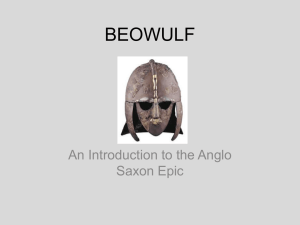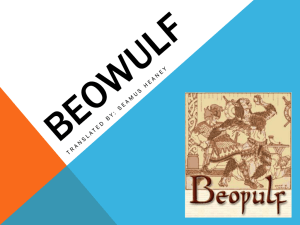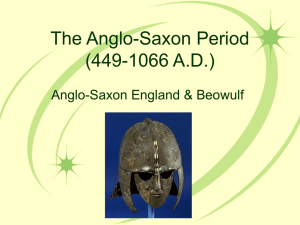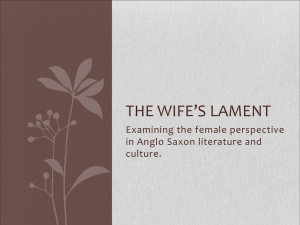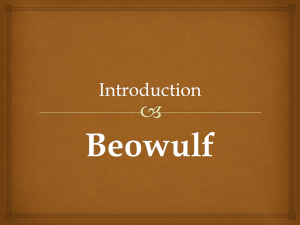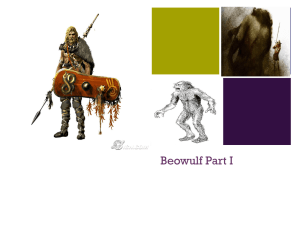Beowulf1 - WordPress.com
advertisement
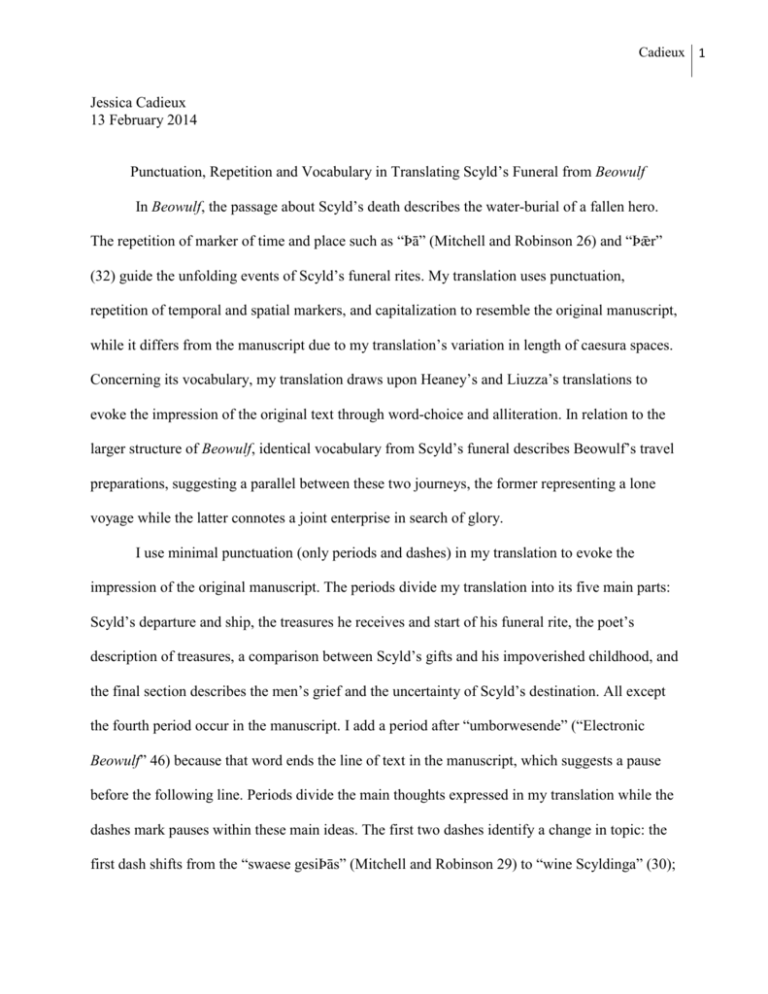
Cadieux 1 Jessica Cadieux 13 February 2014 Punctuation, Repetition and Vocabulary in Translating Scyld’s Funeral from Beowulf In Beowulf, the passage about Scyld’s death describes the water-burial of a fallen hero. The repetition of marker of time and place such as “Þā” (Mitchell and Robinson 26) and “Þǣr” (32) guide the unfolding events of Scyld’s funeral rites. My translation uses punctuation, repetition of temporal and spatial markers, and capitalization to resemble the original manuscript, while it differs from the manuscript due to my translation’s variation in length of caesura spaces. Concerning its vocabulary, my translation draws upon Heaney’s and Liuzza’s translations to evoke the impression of the original text through word-choice and alliteration. In relation to the larger structure of Beowulf, identical vocabulary from Scyld’s funeral describes Beowulf’s travel preparations, suggesting a parallel between these two journeys, the former representing a lone voyage while the latter connotes a joint enterprise in search of glory. I use minimal punctuation (only periods and dashes) in my translation to evoke the impression of the original manuscript. The periods divide my translation into its five main parts: Scyld’s departure and ship, the treasures he receives and start of his funeral rite, the poet’s description of treasures, a comparison between Scyld’s gifts and his impoverished childhood, and the final section describes the men’s grief and the uncertainty of Scyld’s destination. All except the fourth period occur in the manuscript. I add a period after “umborwesende” (“Electronic Beowulf” 46) because that word ends the line of text in the manuscript, which suggests a pause before the following line. Periods divide the main thoughts expressed in my translation while the dashes mark pauses within these main ideas. The first two dashes identify a change in topic: the first dash shifts from the “swaese gesiÞās” (Mitchell and Robinson 29) to “wine Scyldinga” (30); Cadieux 2 while the second dash transitions between “lēofne Þēoden” (34) and “mādma fela” (36). The last dash marks a syntactic pause and emphasizes the caesura, slowing my translation’s pace to stress the mournful tone of the last few lines. These few punctuation marks evoke the minimal punctuation in the original manuscript and distinguish the main ideas in this passage. Compensating for the little punctuation, my translation repeats temporal and spatial markers to indicate pauses, to introduce new subjects and to structure Scyld’s formalized funeral rites. Highlighting the repetition of the word “ðā” (26), which occurs four times with the meaning of “then” or “when”, and the repetition of “ðaer” (32) which appears twice, my translation moves these time and place referents to the beginning of lines and capitalizes them. “Then” and “there” mark where there would otherwise have been periods at the end of the preceding line in my translation. “Đā” (34) and “ðaer” (32) often mark a change in subject and contribute to the unfolding of narrative. For instance, the passage begins with “Him ðā Scyld gewāt” (26), in which Scyld is the subject. Scyld’s men “hī hyne Þā aetbǣron” (28) later become the subject, which then shifts to the ship which “Þǣr aet hȳðe stōd” (32). The line “ālēdon Þā” (34) implicitly changes the subject back to Scyld’s men since the verb is plural. In every one of these lines, either “Þā” (34) or “Þǣr” (32) help identify the change in subject. “Đā” (26) also unfolds the sequence of events: Scyld’s men first “hyne Þā ætbǣron” (28), after which they “aledon Þā lēofne Þēoden”(34) and finally they “Þā gȳt hīe him āsetton segen gyldenne” (47). The reoccurrence of “Þā” (28) in these lines emphasizes the procedural nature of Scyld’s funeral rites. “Þā” (28) slows the poetry’s pace and highlights the formality of the funeral rites. My translation uses “then” and “there” to mark a change in subject, which is the similar function of “Þā” (34) and “ðǣr” (32) in the original text. Just as punctuation and temporal and spatial markers contribute to my translation’s resemblances to the original manuscript, capitalization gives my translation a similar appearance Cadieux 3 to the manuscript in comparison to other versions. Heaney and Liuzza both capitalize proper nouns in their translations, while this one does not. The manuscript does not capitalize names, such as Scyld, which gives my interpretation the same perplexing effect as the manuscript: proper names are harder to identify than in Heaney’s and Liuzza’s versions. Furthermore, my rendition only capitalizes words at the beginning of new sections within the passage, whereas Heaney and Liuzza both adhere to more modern conventions of capitalization. Just as capitalization is seldom used other than to identify a new section in the original manuscript, words are only capitalized at the beginning of new sections within my translation. The longer caesuras render the subsections of this passage visually salient and highlight the repetition of “then”. Although these longer caesuras do not reflect the spaces between half lines in the manuscript, there are a few unusually long spaces in the manuscript which inspire the long caesuras in my translation. For example, there is a longer space between “Þēodgestrēonum Þon” and “Þā dydon” (“Electronic Beowulf” 28) which divides the line differently than Mitchell and Robinson’s edition, because the break in the manuscript occurs between “Þon” and “Þā” rather than between “Þēodgestrēonum” and “Þon” (Mitchell and Robinson 44). Another perplexing long space in the manuscript occurs between “Þā gȳt hīe him āsetton segen gyl” and “denne” (“Electronic Beowulf” 47), thus unusually separating the word “gyldenne” in half. These odd divisions in the manuscript inspire the long caesuras in my translation of the passage concerning Scyld’s funeral. Now that the punctuation, repetition, capitalization and caesuras of my translation have been discussed, I will show how Liuzza’s and Heaney’s interpretations influence the vocabulary of my translation and contribute to my translation’s evocation of the manuscript through wordchoice. Like Liuzza, I stay faithful to the original spelling of names such as “Scyld” (Liuzza 26), Cadieux 4 while Heaney modernizes this name to “Shield” (26). Maintaining the old English spelling of names evokes the archaic impression these names bear. Heaney and Liuzza translate “hringedstefna” (Mitchell and Robinson 32) as “ring-whorled prow” (Heaney 32) and “ringprowed ship” (Liuzza 32) which inspire my translation’s interpretation as “ring-prowed ship” (Cadieux 32), instead of Mitchell and Robinson’s suggestion of “curve-prowed ship” (272). “Ring-prowed ship” (Liuzza 32) is the closest modern equivalent to “hringedstefna” (Mitchell and Robinson 32) due to its similar pronunciation. My translation interprets “felahror” (Mitchell and Robinson 27), thanks to Heaney, as “thriving” (Heaney 26) because it allows for the same amount of stressed syllables in the half line as in the original text. “Felahror feran” (Mitchell and Robinson 27) has a strong stress on the first syllable of each word just as “thriving he crossed” (Cadieux 27) stresses the first syllables of “thriving” and “crossed”. The examples of Scyld’s name’s spelling, “hringedstefna” (Mitchell and Robinson 32) and “felahror” (27) show Heaney’s and Liuzza’s influence on my translation’s word-choice. Although my translation does not adhere to the manuscript’s alliterative verse form, some lines convey the effect of alliteration and consonance to recall the effect of alliteration in Beowulf. Like Liuzza’s, my translation interprets “æÞelinges fær” (33) as “a nobleman’s vessel” (Liuzza 33) because the “s” sound in “vessel” (33) reminisces the “s” sounds in “icy and set for sea” (Cadieux 33). My translation also alliterates “trove of treasures” with “travel” (41) just as the manuscript alliterates “mādma mænigo” with “mid” (Mitchell and Robinson 41). Instead of euphemistically addressing the ocean as “the Deep” (Liuzza 49), I change the verb “gēafon” (Mitchell and Robinson 49) to “offered” in order to alliterate “offered” with “ocean”(Cadieux 49). Like the manuscript alliterates “flōdes” with “feor” (Mitchell and Robinson 42), my translation Cadieux 5 alliterates “fare far” with “flood” (Cadieux 42). These instances of alliteration and consonance in my translation reminisce the original text’s alliterative meter. The vocabulary describing Scyld’s funeral process echoes in Beowulf’s travel preparations, drawing a parallel between Scyld’s funeral rites and Beowulf’s sea travel. Both Beowulf’s and Scyld’s ships are “gegyrwan” (Mitchell and Robinson 38 & 199) for the voyage, their ships’ “bearm” (35 & 214) are filled with treasures “frætwa” (37),“frætwe” (214) and war gear. Both Scyld and Beowulf “gewāt” (26 & 210), or depart. While Beowulf sets out with fourteen other chosen warriors “cempan gecorone” (206), Scyld’s men are left on the shore with “murnende mōd” (50). Scyld’s separation from his companions emphasizes the sense of loss and despair. Furthermore, the uncertainty of Scyld’s destination contrasts with Beowulf’s “wilsīð” (216), desired journey, because Beowulf sets out with the intention of confronting Grendel while Scyld heads into unknown territories. These contrary voyages united with identical vocabulary highlight the similarities and differences between Scyld and Beowulf. In brief, my translation uses minimal punctuation, has longer caesuras spaces and repeats “then” to mark different sections within the passage. As in the manuscript, “then” highlights the formality of Scyld’s funeral rites. My translation only capitalizes the beginning of subsections within the passage, as in the manuscript. Although my translation does not adhere to Beowulf’s meter, its alliteration evokes the original text. Heaney’s and Liuzza’s translations inspire the vocabulary of this interpretation. Vocabulary plays an important part in Scyld’s funeral passage, because the same words reoccur in descriptions of Beowulf’s travel preparations, linking together these two journeys. While Beowulf and his warrior-band set off for a heroic journey, Scyld departs from this world alone, heading towards the unknown. Cadieux 6 Works Cited Cadieux, Jessica. Trans. Beowulf: “Scyld’s Funeral” Lines 26-52. 2014. Print. “Electronic Beowulf”. eds. Kevin Kiernan, Andrew Prescott, Elizabeth Solopova, David French, Linda Cantara, Michael Ellis & Cheng Jiun Yuan. British Library & University of Michigan Press. 1999. CD-ROM. Heaney, Seamus. trans. Beowulf. The Norton Anthology of English Literature: The Middle Ages Volume One. Ed. Stephen Greenblatt. New York: W.W. Norton & Company. 2012. 41108. Print. Mitchell, Bruce. & Fred C. Robinson. trans. Beowulf: an edition with relevant shorter texts. Oxford: Blackwell Publishing, 2004. Print. R.M. Liuzza. trans. Beowulf. Peterborough: Broadview Press, 2000. Print.

